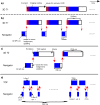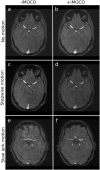Improvement in diagnostic quality of structural and angiographic MRI of the brain using motion correction with interleaved, volumetric navigators
- PMID: 31100092
- PMCID: PMC6524807
- DOI: 10.1371/journal.pone.0217145
Improvement in diagnostic quality of structural and angiographic MRI of the brain using motion correction with interleaved, volumetric navigators
Abstract
Introduction: Subject movements lead to severe artifacts in magnetic resonance (MR) brain imaging. In this study we evaluate the diagnostic image quality in T1-weighted, T2-weighted, and time-of-flight angiographic MR sequences when using a flexible, navigator-based prospective motion correction system (iMOCO).
Methods: Five healthy volunteers were scanned during different movement scenarios with and without (+/-) iMOCO activated. An experienced neuroradiologist graded images for image quality criteria (grey-white-matter discrimination, basal ganglia, and small structure and vessel delineation), and general image quality on a four-grade scale.
Results: In scans with deliberate motion, there was a significant improvement in the image quality with iMOCO compared to the scans without iMOCO in both general image impression (T1 p<0.01, T2 p<0.01, TOF p = 0.03) and in anatomical grading (T1 p<0.01, T2 p<0.01, TOF p = 0.01). Subjective image quality was considered non-diagnostic in 91% of the scans with motion -iMOCO, but only in 4% of the scans with motion +iMOCO. iMOCO performed best in the T1-weighted sequence and least well in the angiography sequence. iMOCO was not shown to have any negative effect on diagnostic image quality, as no significant difference in diagnostic quality was seen between scans -iMOCO and +iMOCO with no deliberate movement.
Conclusion: The evaluation showed that iMOCO enables substantial improvements in image quality in scans affected by subject movement, recovering important diagnostic information in an otherwise unusable scan.
Conflict of interest statement
MA is an employee of Philips Danmark A/S.
Figures






References
-
- Andre JB, Bresnahan BW, Mossa-Basha M, Hoff MN, Smith CP, Anzai Y, et al. Towards Quantifying the Prevalence, Severity, and Cost Associated With Patient Motion During Clinical MR Examinations. J Am Coll Radiol. Elsevier Inc; 2015;12(7):689–95. - PubMed
-
- Tornqvist E, Mansson A, Larsson EM, Hallstrom I. Impact of extended written information on patient anxiety and image motion artifacts during magnetic resonance imaging. Acta Radiol. England; 2006. June;47(5):474–80. - PubMed
Publication types
MeSH terms
LinkOut - more resources
Full Text Sources

